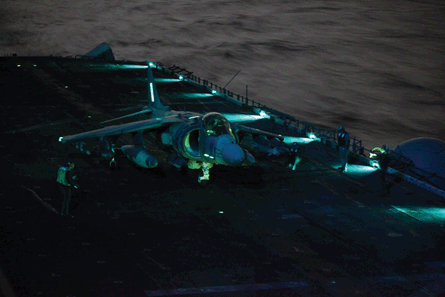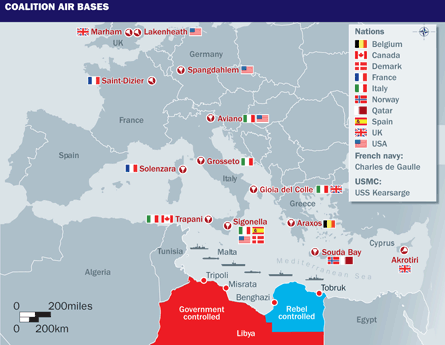Twenty-five years after its ill-fated attempt to remove Col Muammar Gaddafi from power, the USA is again involved in military action over Libya. However, unlike its long-range "El Dorado Canyon" strikes conducted in 1986 using General Dynamics F-111 bombers, this time Washington is acting at the head of a 13-nation coalition and in response to a UN security council resolution.
Many were surprised at the speed of the international community's response to the passing of resolution 1973 - which calls for the use of "all necessary measures to protect civilians under threat of attack" in Libya - with the first strikes launched within 48h of its approval in New York on 17 March.
 |
|---|
© USAFRICOM |
With first priorities being to take down Gaddafi's air defence systems and command and control network, while also limiting the movements of his air force by enforcing a no-fly zone, the opening salvoes involved the launch of more than 110 Tomahawk land attack missiles from US Navy frigates and submarines and by the UK Royal Navy.
Supporting this effort were three US Air Force Northrop Grumman B-2 stealth bombers, which conducted a more than 25h mission against targets including hardened aircraft shelters at Ghardabiya air base from Whiteman AFB, Missouri.
A large package of strike and support aircraft from allies including France, Italy and the UK also took part.
As in the opening hours of the 2003 Iraq War, Royal Air Force Panavia Tornado GR4s released MBDA Storm Shadow cruise missiles against air defence targets. Several of the aircraft completed a 2,600nm (4,800km) strike, mounted from their Marham base in Norfolk on 20 March, in what was the longest-range offensive mission conducted by the RAF since its "Black Buck"-series flights with Avro Vulcans during the Falklands War.
French air force assets, which included Dassault Mirage 2000D strike aircraft and Rafales armed with Sagem AASM air-to-surface missiles, were among the first to target pro-Gaddafi forces on the ground near the opposition stronghold of Benghazi, along with Boeing AV-8B Harrier IIs of the US Marine Corps.
Also at the "tip of the spear" during the opening hours of Operation "Odyssey Dawn" were Italian air force Tornado electronic combat and reconnaissance aircraft and USAF Lockheed Martin F-16CJs, both armed with Raytheon AGM-88 high-speed anti-radiation missiles.
The USN's newly fielded Boeing EA-18G Growler electronic attack aircraft also made its combat debut, with five having been quickly moved to Aviano air base in Italy from their operational commitments in Iraq.
During the first five days of the offensive the coalition flew 336 sorties, with US assets having performed 212 of these.
Strike action was required in 108 of the total missions flown, according to the US Department of Defense. Another 52 Tomahawk missiles had also been fired by 23 March, it said.
Operations had, by then, also expanded as other aircraft arrived in the region. These included assets from Belgium, Canada, Denmark, Norway, Qatar and Spain.
The Netherlands also began preparations to deploy six F-16s and a McDonnell Douglas KDC-10, while the Swedish government has offered to deploy up to eight of its Saab JAS 39 Gripens if requested to do so.
The UK moved four of its Tornado GR4s and 10 Eurofighters to Gioia del Colle air base in Italy, with the latter action representing the first combat deployment with the Typhoon.
The type made its debut on 21 March, when several were involved in a nearly 5h 30min mission in policing the no-fly zone. Each carried Raytheon AIM-120 AMRAAM and MBDA ASRAAM air-to-air missiles, plus a 27mm Mauser cannon.
 |
|---|
Italy had also flown several of its Eurofighters from Grosseto to Trapani, Sicily in readiness to support the coalition operation, armed with Diehl BGT Defence IRIS-T short-range air-to-air missiles and AMRAAMs.
However, as of 23 March its air force had instead used four of its F-16s to support operations with its Tornado ECRs.
Also on the move were Boeing F-15Es, which had initially supported "Odyssey Dawn" from RAF Lakenheath in the UK but repositioned to Sigonella, Sicily. One of these was involved in the campaign's only early loss, when it crashed in eastern Libya on 21 March after it "experienced equipment malfunction". Both crew members were rescued after ejecting from the aircraft.
With no surface-to-air missiles having been launched in the previous four days, the RAF's commander of air operations Air Vice Marshal Greg Bagwell said on 23 March: "We are now applying sustained, unrelenting pressure on the Libyan armed forces. Their air force no longer exists as a fighting force, and its integrated air defence system and command and control networks are severely degraded to the point that we can operate over [Libyan] airspace with impunity."
However, although Gaddafi's fixed air defences have largely been removed, coalition pilots still face the potential threat posed by mobile SA-6 and SA-8 SAMs, man-portable SA-7s and thousands of anti-aircraft guns.
The coalition's early emphasis on conducting strike missions had, by this time, already evolved into what is effectively an over-watch activity.
UK Tornados made several sorties with the type's Goodrich Raptor pod, while others deployed lighter weapons, such as the MBDA dual-mode Brimstone air-to-surface missile and Raytheon Systems' Paveway IV precision-guided bomb. Newly arrived in the Mediterranean, the French navy's aircraft carrier Charles de Gaulle also deployed Rafale Ms carrying Reco NG pods to support the surveillance task.
Much pre-campaign work had been done from early March, using assets such as NATO Boeing E-3A airborne warning and control system aircraft and RAF Raytheon Systems Sentinel R1 ground surveillance aircraft, with the latter operating from its Akrotiri base in Cyprus.
Unusually, the task of conducting such activities has so far remained the almost exclusive responsibility of piloted assets, with only one sortie known to have been performed using an unmanned air vehicle.
This involved a USAF Northrop RQ-4 Global Hawk, operating from Sigonella. The absence of other unmanned systems highlights the challenge of flying such equipment in Europe's congested airspace, but also stems from the operational and logistical difficulty involved in removing such vital systems from conducting round-the-clock operations over Afghanistan and Iraq.
With Gaddafi's air defence system and air force effectively out of the equation, the US-led coalition now finds itself in a parallel situation to that encountered during NATO's 1999 Operation "Allied Force" against the Serbian leadership. Air power has delivered on its initial goals, but without the participation of ground forces, uncertainty surrounds the campaign's future progress. This could hinge on more effective opposition activities staged from Benghazi towards the capital Tripoli, or on the armed forces turning against Gaddafi.
Although potentially facing the risk of stalemate where their adversary clings to power, Western officials appear determined to maintain their action for as long as it takes.
"I think no-one was under any illusions that this would be an operation that would last one week or two weeks or three weeks," US Secretary of Defense Robert Gates says.
"This is a multi-phased operation. Our coalition partners are assuming more and more responsibility," US Navy Rear Adm Gerard Hueber, chief of staff of Joint Task Force Odyssey Dawn, says.
However, while NATO launched maritime campaign "Unified Protector" on 23 March to enforce the arms embargo against Gaddafi's regime, and completed plans to help enforce the no-fly zone, details of a proposal to eventually assume responsibility for the operation from the USA remain unclear.
However, the alliance has already stressed it has "no intention of deploying land forces anywhere in Libyan territory".
Beyond Libya itself, the USA and its coalition partners are also hoping the presence of a large multinational force could help to ease tensions in other countries in the region. With instability continuing to rumble on in Bahrain and major unrest also mounting, this could prove to be a highly optimistic view.
Source: Flight International



















